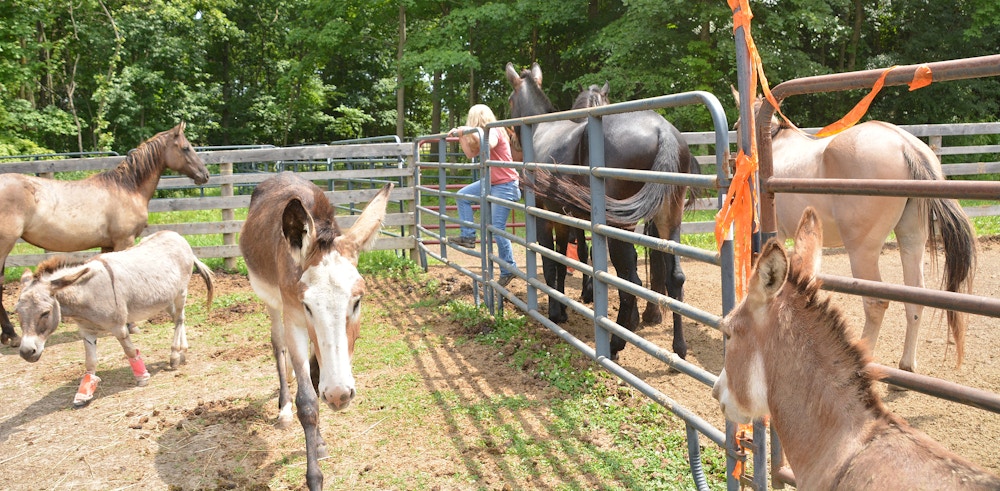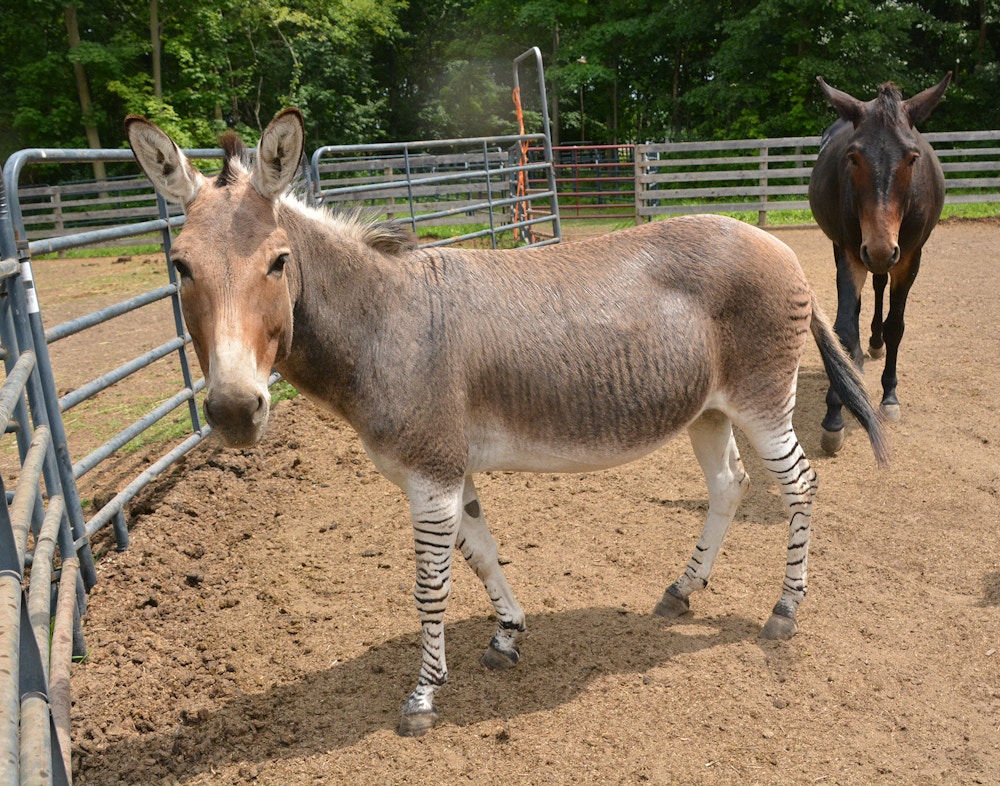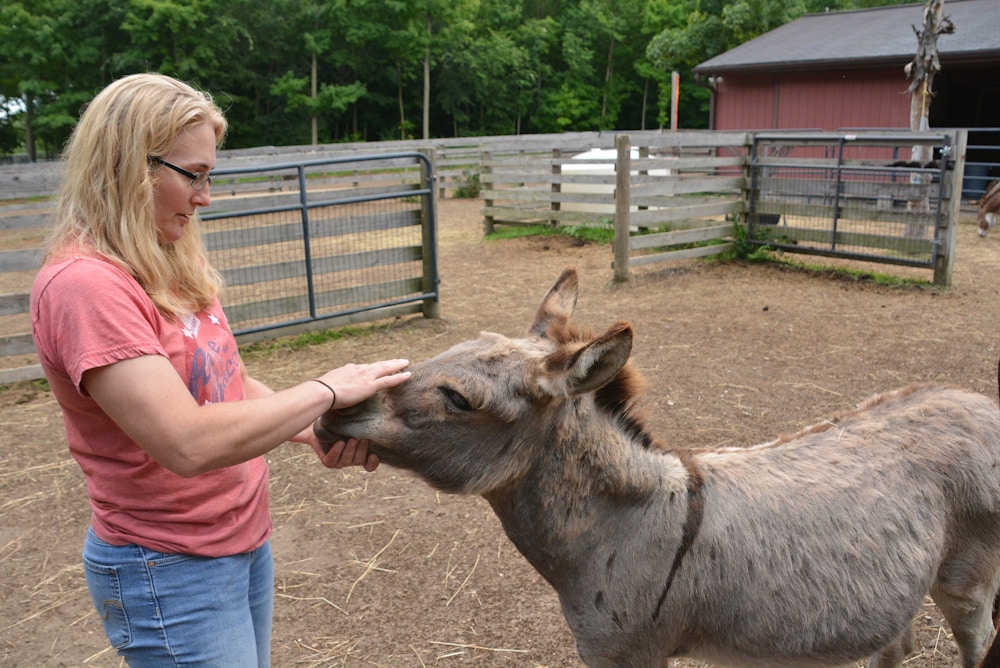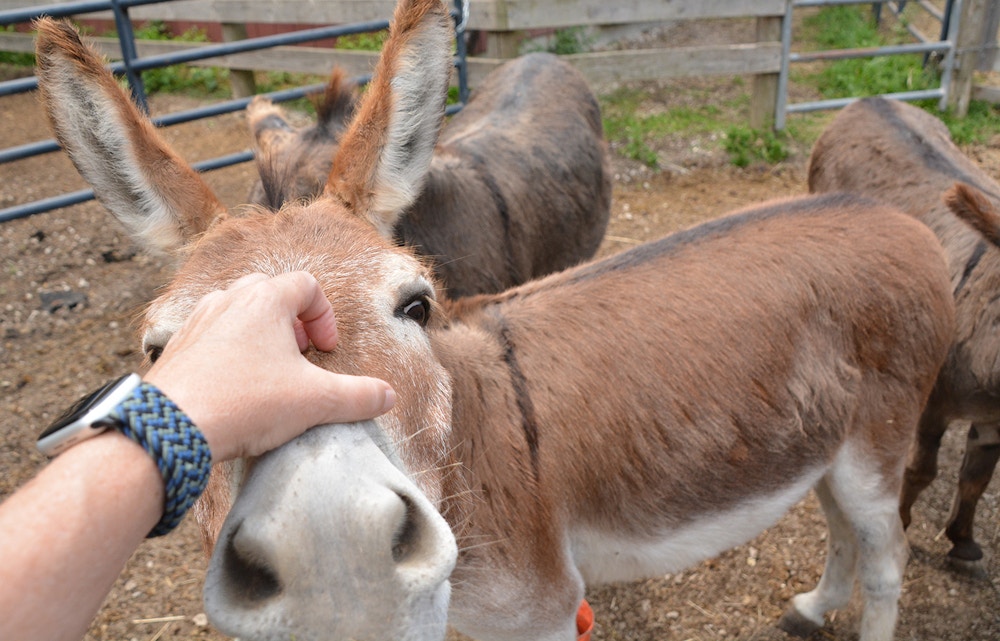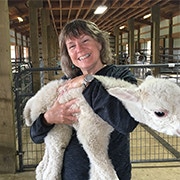Apr. 12, 2022
•9 min read
Astronaut. Fireman. Rockstar. Doctor. Professional athlete. After we grow up, our paths often take very different trajectories from what we dreamed about becoming when we were children. Unless you're Danielle Faucett. She knew as a child she wanted to be a zookeeper and, more specifically, a zookeeper for zebras, camels, and other hooved critters. Today that is exactly what she does as the Area Supervisor of Winter Quarters at the Milwaukee County Zoo. I'm here to say she didn't steal my dream from me. She earned it.
“Since I was a little kid, I wanted to be the supervisor of Winter Quarters,” Faucett told me. It's called the Winter Quarters because that's where they once housed many of the animals who were accustomed to a more temperate climate during cold Wisconsin winter months. Today, this area exhibits animals such as zebras, camels, greater kudu, Thomson’s gazelle, tapir, and one spunky southern ground hornbill, a bird with a beak more like a sword than a pocketknife. Faucett calls this a “nice little mix” of animals. But does she have a favorite?
“It's the camels. It always has been. I used to think that zebras were my favorite,” Faucett mused. “But I started working for a private zoo, and the boss ended up including me in a lot of the camel training. And they are addictive. They are so smart. They can be so laid back and so loving. They are just so fun to be around.”
Faucett gave up a coveted spot as an elephant keeper to get to her dream spot. “When the elephant manager left, I became the elephant manager for a little bit. I voluntarily gave up that position, though, as more and more chances to be temporary supervisor at Winter Quarters occurred. And then I transferred down there because I felt like, this is my chance,” Faucett said. “Honestly, that's where I'm currently planning on staying until I retire. So, that's my dream.”
Her love of everything equine and the zoo began with her parents taking her there often as a child. “I actually fell in love with Cody, their miniature horse, who was born the same year as me. So, as a kid, I kind of grew up with Cody the miniature horse,” Faucett recalled.
Her love of equines then blossomed with a single raffle ticket and a smattering of luck. “I was 13, and my mom bought a [winning] raffle ticket to help support a horse organization, where they do endurance riding," Faucett said. “And the prize was $500 or a horse. I made her take the horse.”
She now has 12 equines of her own, including four miniature donkeys, three horses, one mammoth donkey, three mules, and one zedonk. Her experience with zebras makes Faucett uniquely qualified to own a zedonk, a cross between a zebra and a donkey. She doesn't recommend just anyone taking one on unless they know what they are getting into. I asked her to explain the differences between zebras and domesticated equines.
“Zebras have higher self-preservation skills, and they're more willing to fight if you corner them. It's not just flight for them. They will fight,” she stated emphatically. “They are all about survival. They have no problems with communicating, ‘You know, I have teeth and hooves.' If they're cornered, they're not just going to give up where I feel like a lot of horses would.”
Faucett has mixed emotions about acquiring the zedonk. “I got her from a reputable breeder. And I have been working with zebras. So, I felt like this was something I could handle. She is so mentally different from my donkeys and horses,” Faucett said. “You are not going to dominate a zebra mix or a zebra, in my opinion. That is a way to get seriously hurt. Their will to survive; it's up there.”
So how do zookeepers “keep” or care for the wild animals in their charge? Animals like zebras that have a strong fight-or-flight response. I asked Faucett specifically about Niles, the southern ground hornbill with the 7-inch beak who lives in Winter Quarters. How does she get him to do what she wants? I told Faucett that I assumed she is the one in charge and in control.
“Aw, heck no,” Faucett said. “To a certain level, I guess, but you gotta realize that most of these zoo animals have a choice. If I want them to go out on exhibit, I need to somehow make that exhibit more reinforcing than staying in. So, in Niles’ case, I don't interact with him or acknowledge his shenanigans inside. But when he goes out on exhibit, oh my gosh, I go up in the public area, baby talk to him, throw him stuff, throw him a toy, you know. Make being on exhibit more reinforcing. So really, that's how we work with many of our animals. We try to find what's the most reinforcing or rewarding for them. For some, it might be food. It's figuring out whatever makes them tick. And that's how we get the behaviors including shifting [moving on and off exhibit] that we really need.”
There are some basic differences between domesticated animals like cattle, horses, sheep, dogs, chickens—and wild animals. To be domesticated, which takes thousands of years of selective breeding, animals must, among other things, be willing to breed in captivity, have a relatively amiable temperament, and be willing to fall into a social hierarchy with humans as their leaders.
Zebras, tapirs, kudus, and gazelles are not tame or domesticated, even if they are captive. They are wild animals, whether on the Serengeti plains or on exhibit at a zoo. And as any good supervisor at a zoo or at a Fortune 500 company knows, it's better to win your "animals” over with positive reinforcement whenever possible. Food is often a motivator when trying to get compliance from a Siberian tiger, for example.
“We use chicken, meat, sometimes whipped cream. It depends on how high of a reinforcement you need,” Faucett said.
Yet, Faucett wishes she could use positive reinforcement to get a positive reaction from people who hold much passionate animosity toward zoos and even zookeepers themselves. Faucett says she wishes people would have more thoughtful conversations with them about zoos and why they are instrumental in the conservation and continuation of many species.
“I think the key there is a conversation. Many of these people are so passionate about seeing what's good for the animals that they verbally attack you. And it's like, ‘Okay, I understand where you're coming from,’ but if they could actually start a conversation … ” Faucett lamented. She continued, “Zookeeping is a profession that is constantly evolving. We are constantly seeking professional development, going into field research, reading. We are trying always to improve our animal welfare. If you go back 30 or 40 years, oh my gosh, if we were still operating like that, I'd be against zoos too.”
Zoo detractors can be vehemently harsh. In her book, Animal Madness: How Anxious Dogs, Compulsive Parrots, and Elephants in Recovery Help Us Understand Ourselves, Laurel Braitman spends much time disparaging zoos for the treatment of animals, lack of empathy, and poor enrichment. She posits that upgrades to zoos can be worse for the animals because “... new plants and other features can shrink the animals’ usable space,” suggesting that improvements to zoo quarters are antithetical to the animals’ well-being. While Braitman tends to blame zoo management more than the keepers, the keepers are often on the firing line of criticism because they are public facing. I asked Faucett what she would say to zoo detractors, like Braitman, who wish that zoos didn't exist and that animals could simply live out their lives in their true, natural environments.
“Oh, I wish they could. We don't look at our animals and say we want them in captivity. We accept that the animals in our care are part of the bigger picture. We would love for animals to be in the wild. But humans are preventing that from being successful. And if people want to know ways to help us promote more wild areas, oh heck yeah, come talk with us. You'd be surprised how many zookeepers raise money for conservation or to help with field research,” said Faucett. “We are not striving to bring animals into captivity.”
Despite even zookeepers preferring that animals stay wild, and in the wild, it’s not realistic. Loss of habitat, climate change, poaching, and negative human-to-animal encounters are just a few of the reasons that wild animals often die in the wild unless they are fortunate enough to spend their life without human contact. Pat the Great Cat, a jaguar from Belize, found himself in a precarious situation because he found domesticated cattle easier prey than wild tapir. For Pat the Great Cat, his options were either euthanasia or spending his final years being loved and cared for at the Milwaukee County Zoo.
“He was a Belizean jaguar that was older. He had some health issues. He began the easy route and began to attack (Belizean) farmers' cattle. So, they were going to have to euthanize him if something didn't change. The Belize Zoo is amazing in taking in these animals and trying to care for them,” Faucett explained. “So, this cat and other problem males often come in, but this cat ended up getting moved to Milwaukee. He was a wild cat that was acclimated at the Belize Zoo so he could adjust to being in human care. Then he was moved to Milwaukee.”
Although Pat the Great Cat has passed on, he left his legacy through Pat Gives Back, a joint program between the Milwaukee County Zoo and the Belize Zoo. This conservation nonprofit helps fund various efforts, from mitigating conflicts between Belizean farmers and jaguars so they can co-exist to monitoring tapir activity to reduce mortalities.
Zoos also play an integral role in breeding animals that are endangered or on the brink of extinction. Faucett explained that any breeding or even movement of animals in accredited zoos is carefully monitored and administered by the Species Survival Plan Programs (SSP) through the Association of Zoos and Aquariums. These programs ensure appropriate levels of biodiversity and that, based on animals' natural behaviors, they are going to the right locations at the right time. For instance, you may not want to put two male pumas in the same exhibit because adult pumas are solitary animals in the wild.
Without the work and oversight of SSP and its affiliated zoos, a number of animals would now be extinct, including, Faucett mentioned, the California condor and the red wolf.
The last male northern white rhino, Sudan, died on March 19, 2018. The only remaining northern white rhinos left on the planet are his daughter, Najin, and granddaughter, Fatu. They now live in Kenya at Ol Pejeta Conservancy in a state of “functional extinction,” guarded day and night by men with submachine guns.
Northern white rhinos once flourished throughout Africa. Hunting, poaching, and ambivalence have reduced this species to two females and a small bank of Sudan’s sperm gathered by veterinarians and scientists who wiped away tears for his death, then went to work. The embryos from Najin and Fatu and sperm from deceased male white rhinos (including one named Suni), frozen in a lab, hold the only hope for the northern white rhino’s continued existence. Zoos that hold and protect female southern white rhinos are part of that hope through in vitro fertilization and surrogate motherhood. The northern white rhino was annihilated by humans, but it could be saved by humans who are zookeepers, zoo veterinarians, and the staff and management behind the scenes.
I asked Faucett to look into her crystal ball and project, with her degree in biology and 20-plus years of experience working with zoos, what she sees in the future for zoos.
“We are always going to try to expand our knowledge of improving their welfare one way or another. When people say enrichment, a lot of people think you just throw toys. We are pushing more and more to try to provide experiences for animals that mimic what they would see in the wild. Let's face it, a lot of behaviors in the wild are based on trying to find food. In the wild, they're forced to move thousands of miles to forage. That might be natural, but it's not pleasurable.” (Or realistic in a zoo environment.)
Another change, Faucett said, would have to do with space. Lots and lots of space. Like the Milwaukee County Zoo, other accredited zoos are doing everything they can to create bigger and more natural spaces for the animals on exhibit. But land within a zoo's confines is limited, as are its finances.
“The downside is that [expansion] costs so much money. It is not cheap. And you still have to make it safe.” She continued, “If you think about it, a little ten-by-ten cage was acceptable back then. And now we're trying to get more open air and grass. Milwaukee is a very old zoo, but even we are trying to improve. We got a larger elephant facility. We've got grass. We had trees until they destroyed them. [laughs] But they are trying. They are trying constantly,” Faucett said.
We ended our conversation by taking a short drive from the noisy coffee shop where we began our conversation to visit Faucett’s personal menagerie of horses, donkeys, mules, and one willful zedonk, who we found basking in their paddocks. Eleven equines and 44 hooves. Faucett works all day at Milwaukee County Zoo with an exotic mix of hooved critters, then comes home to spend her evenings with another group of domesticated equines. She just can't seem to get enough. “This is my happy place,” Faucett said. “This is where people come when they need a little donkey therapy.”
Upon entering a paddock, I was quickly surrounded, followed, nudged, and monitored by each and every one of her herd, except the zedonk, named Mitzi, who eyed me up just out of arm’s reach with a mix of curiosity and suspicion. I was able to connect physically with all of the equines but one. The domesticated horses, mules, and donkeys followed me, accepting me eagerly without hesitation as “one of the herd.” Even the yearling filly, Qadira, whom Faucett recently rescued from what she described as the equivalent of a “puppy mill of horses,” was willing to accept my touch. But Mitzi, with two hooves in domestication and two in the wild, would not yield to a gentle stroke of my hand. As Faucett had told me about the zedonk, “She loves a good ear rub and all that, but she also knows, ‘You’re on that side of the fence. This is mine. You come in here; you're not coming near me. I don't trust you.’”
I know that’s just the nature of working with animals, wild or domesticated. Trust isn’t always easily given. It is earned and grows over time, centuries in some cases. Considering the relationship between humans and nonhuman animals throughout history, it’s best for animals not to trust us too easily. Looking for a path of escape and keeping their distance is their best assurance of survival. To flee. To get away from us, or if needed, to fight hoof, tooth, and claw. I can’t say I blame animals; it certainly doesn’t make me proud of humanity and our tenuous stewardship of animals. It hits me especially hard as I stand here surrounded by these sweet, inquisitive beings who have willingly given me their trust. They just want to be with me. They have great energy and are not afraid to share it with me. What a gift to be given so freely and without question. In the name of humanity, I hope I am deserving of it.
More Articles by Joette Rockow
May. 23, 2023
•8 min read
Apr. 25, 2023
•9 min read
Jul. 13, 2022
•8 min read
About the author
Joette is a Senior Lecturer at UW-Milwaukee where she teaches advertising, public relations, and common sense. She is a writer, musician, Taoist, animal lover, and enjoys a good hike, a cold beer, and a belly laugh with friends.

